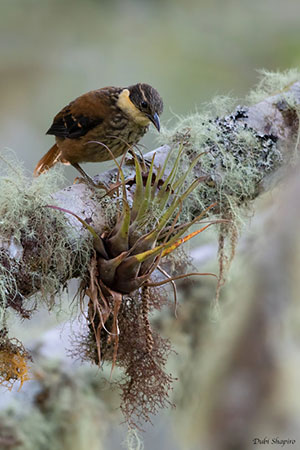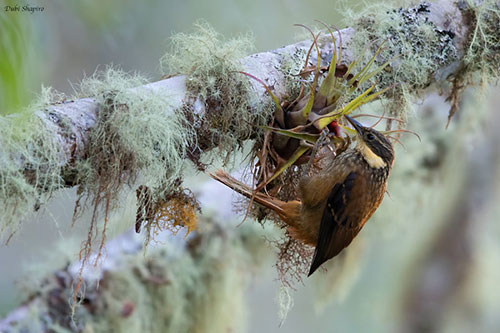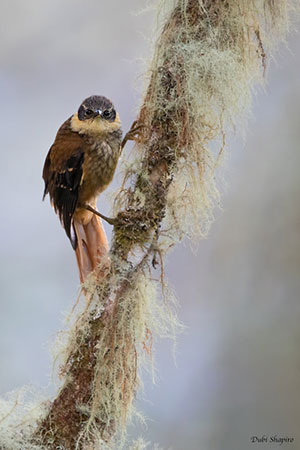
REPRODUCTION OF THIS SPECIES:
The breeding season takes place between January and May in Costa Rica.
The Buffy Tuftedcheek is probably monogamous.
The nest is placed inside a natural cavity or an old woodpecker hole, often in decaying tree trunk. It is placed several metres above the ground. The only observed nest was about 9-10 metres high in forest opening.
The cavity is usually lined with pieces of plant matter, often brown tree-fern scales.
The female lays a single egg. From the observation of a nest, only one adult was incubating and then feeding the chick. The adult at nest is probably the female, because her longer bill allows her to search for food in more numerous plant species to feed her chick. The young leave the nest about 30-31 days after hatching.
PROTECTION / THREATS / STATUS:
The Buffy Tuftedcheek has small range in which it is described as uncommon and patchily distributed. It is rare in W Panama. However, the species is present in several protected areas.
The size of the population is unknown, but it is suspected to be stable as declines or substantial threats are absent.
The Buffy Tuftedcheek is not globally threatened and currently evaluated as Least Concern.
Fr: Anabate chamois
Ang: Buffy Tuftedcheek
All: Fahlwangen-Astspäher
Esp: Trepamusgos Barbablanca Panameño - Barbablanca Anteada (Panama)
Ita: Guanciariccia camoscio
Nd: Panamese Pluimoor
Sd: bandvingad ullkrage
Photographer:
Dubi Shapiro
Dubi Shapiro Photo Galleries
Text by Nicole Bouglouan
Sources:
HANDBOOK OF THE BIRDS OF THE WORLD Vol 8 By Josep del Hoyo-Andrew Elliott-David Christie - Lynx Edicions - ISBN: 8487334504
BIRDS OF SOUTH AMERICA – Passerines - by Robert S. Ridgely and Guy Tudor – HELM Field Guides – ISBN: 9781408113424
A GUIDE TO THE BIRDS OF COLOMBIA by Steven L. Hilty and William L. Brown - Princeton University Press – ISBN 069108372X
Birds of Ecuador De Robin Restall, Juan Freile – Editeur: Bloomsbury Publishing, 2019 – ISBN: 147297249X, 9781472972491 - 576 pages
Birds Of Central America De Andrew C. Vallely, Dale Dyer – Editeur: Princeton University Press, 2018 – ISBN: 0691138028, 9780691138022 – 584 pages
Wikipedia, la enciclopedia libre
Wikipedia, the free encyclopaedia
Buffy Tuftedcheek
Pseudocolaptes lawrencii
Passeriformes Order – Furnariidae Family
INTRODUCTION:
The Buffy Tuftedcheek is one of the three members of the genus Pseudocolaptes in the large family Furnariidae. It is treated here as full species, although depending on the authors, this species is the nominate race whereas P. johnsoni from Ecuador and Colombia is a subspecies named Pacific Tuftedcheek.
The Tuftedcheek species are highly specialized on searching for food through dense bromeliads and epiphytic vegetation in humid montane forest. They often catch small frogs found in the water provided by the central cup of the bromeliads.
The Buffy Tuftedcheek shows strong sexual dimorphism as the female has significantly longer bill than male, which is very unusual and even unique among the Passeriformes.
From an observation, only one parent attends the nest, maybe a unique phenomenon within the family Furnariidae. This fact could indicate that the brood is fed only by the female which may search for prey in more numerous plant species, thanks to her longer bill.
The Buffy Tuftedcheek frequents the humid montane forest, mainly above 1,600 metres of elevation and up to 3,000 metres in Costa Rica and C Panama where it is resident.
The Buffy Tuftedcheek has small range in which it is uncommon to fairly common. But currently, the species is not globally threatened.

DESCRIPTION OF THE BIRD:
Biometrics:
Length: 20-21 cm
Weight: 48 g
The Buffy Tuftedcheek has rufous-brown upperparts with faint blackish scalloping. Rump and uppertail-coverts are bright chestnut-rufous. On the blackish-brown upperwing, the coverts have pale rufous/ochraceous-buff tips forming two narrow pale wingbars. The long, graduated tail is rufescent, with pointed rectrices.
On the underparts, the throat is whitish with pale tawny wash. The upper breast is buffy white with dark brown scaling and mottling, whereas the lower breast shows whitish shaft streaks. Rest of underparts is fulvous-brown but more rufescent on the body sides. The undertail-coverts are ochraceous/cinnamon.
On the dark head, we can see a conspicuous buffy-white supercilium. Lores and ear-coverts are blackish-brown. Malar area to neck sides is pale buff. The feathers continue back on neck sides forming a prominent tuft. The crown is blackish-brown and densely, but finely streaked with buff. A hind collar of pale buff streaks contrasts with the blackish-brown colour of the upper mantle.
The fairly long, slightly decurved bill has blackish upper mandible whereas the lower mandible is variable and often paler with dark area in the centre. The eyes are dark brown. Legs and feet are olive-green to yellowish-olive.
Male and female have similar plumage, but the female has longer bill than male.
The juvenile has shorter bill than adults. The crown is blackish-brown. Throat and breast show blackish-brown scalloping whereas flanks and belly are more rufescent.
RANGE:
The Buffy Tuftedcheek is found in the mountains of Costa Rica, S to C Panama (E to Coclé).
HABITAT:
The Buffy Tuftedcheek frequents humid evergreen montane forest, preferring open areas and edges. It is often found in clearings with trees. The species usually occurs between 1,600 and 3,000 metres of elevation.
CALLS AND SONGS: SOUNDS BY XENO-CANTO
The Buffy Tuftedcheek’s call is a loud, metallic “jeenk” or “pweenk”.
The song is a series of 1-4 sharp, clear notes followed by a trill first rising in pitch and then slowing and falling “peenk peenk peenk priiiiieeeee”.
BEHAVIOUR IN THE WILD:
The Buffy Tuftedcheek feeds mainly on arthropods and occasionally takes small amphibians. The diet includes Dermaptera, Blattodea (cockroaches), Orthoptera, insect eggs, Coleoptera, larvae of Lepidoptera and spiders.
But the species is known for feeding on small frogs and salamanders found in tank bromeliads. These plants often contain small “pools” of water in the flower’s centre, and some small amphibians can be found in the water, but high in the canopy.

The Buffy Tuftedcheek forages in midstorey to subcanopy of humid, cloud forest. It creeps and hops along branches while probing vigorously in epiphytes and especially bromeliads. It frequently uses its long tail as support.
It probes and rummages noisily in all wood crevices but also in the bromeliads where debris are accumulated. It props itself with help of the long, stiff tail, but it also climbs inside the plants. It probes mosses and epiphytes from midstorey to upper canopy while clambering along branches.
It forages alone or in pairs, and may sometimes forage with mixed-species flocks.
The Furnariidae appear to be territorial all year round, and they often remain in their small territories.
The breeding behaviour of the Buffy Tuftedcheek is poorly known. Only one nest has been studied, and only one parent was observed attending the nest.
The ovenbirds of genus Pseudocolaptes (among others) are known to use a natural hollow or an abandoned woodpecker hole in which the nest is placed.
The courtship behaviour in unknown, but we can suggest that the conspicuous buffy tuft around the upper neck plays a role in displays, and the plumage pattern is clearly emphasized.
The Buffy Tuftedcheek is resident and remains in its range throughout the year.
As a sedentary species and in the absence of aerial foraging, this species is among the ovenbirds which have relatively short, rounded, slightly pointed wings that don’t allow long-distance flights.
